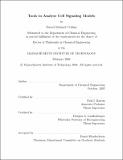| dc.contributor.advisor | Paul I. Barton and Douglas A. Lauffenburger. | en_US |
| dc.contributor.author | Collins, David Michael, 1975- | en_US |
| dc.contributor.other | Massachusetts Institute of Technology. Dept. of Chemical Engineering. | en_US |
| dc.date.accessioned | 2007-02-22T15:55:26Z | |
| dc.date.available | 2007-02-22T15:55:26Z | |
| dc.date.copyright | 2004 | en_US |
| dc.date.issued | 2004 | en_US |
| dc.identifier.uri | http://hdl.handle.net/1721.1/36322 | |
| dc.description | Thesis (Ph. D.)--Massachusetts Institute of Technology, Dept. of Chemical Engineering, 2004. | en_US |
| dc.description | This electronic version was submitted by the student author. The certified thesis is available in the Institute Archives and Special Collections. | en_US |
| dc.description | Includes bibliographical references (v. 2, leaves 345-369). | en_US |
| dc.description.abstract | Diseases such as diabetes, some forms of cancer, hyper-tension, auto-immune diseases, and some viral diseases are characterized by complex interactions within the human body. Efforts to understand and treat these diseases have only been partially successful. There is currently a huge commercial and academic effort devoted to computational biology to address the shortfalls of qualitative biology. This research has become relevant due to the vast amounts of data now available from high-throughput techniques such as gene-chips, combinatorial chemistry, and fast gene sequencing. The goal of computational biology is to use quantitative models to test complex scientific hypotheses or predict desirable interventions. Consequently, it is important that the model is built to the minimum fidelity required to meet a specific goal, otherwise valuable effort is wasted. Unlike traditional chemical engineering, computational biology does not solely depend on deterministic models of chemical behavior. There is also widespread use of many types of statistical models, stochastic models, electro-static models, and mechanical models. All of these models are inferred from noisy data. It is therefore important to develop techniques to aide the model builder in their task of verifying and using these models to make quantitative predictions. The goal of this thesis is to develop tools for analysing the qualitative and quantitative characteristics of cell-signaling models. The qualitative behavior of deterministic models is studied in the first part of this thesis and the quantitative behavior of stochastic models is studied in the second part. A kinetic model of cell signaling is a common example of a deterministic model used in computational biology. | en_US |
| dc.description.abstract | (cont.) Usually such a model is derived from first-principles. The differential equations represent species conservation and the algebraic equations represent rate equations and equations to estimate rate constants. The researcher faces two key challenges once the model has been formulated: it is desirable to summarize a complex model by the phenomena it exhibits, and it is necessary to check whether the qualitative behavior of the model is verified by experimental observation. The key result of this research is a method to rearrange an implicit index one DAE into state-space form efficiently, amenable to standard control engineering analysis. Control engineering techniques can then be used to determine the time constants, poles, and zeros of the system, thus summarizing all the qualitative behavior of the system. The second part of the thesis focuses on the quantitative analysis of cell migration. It is hypothesized that mammalian cell migration is driven by responses to external chemical, electrical and mechanical stimulus. It is desirable to be able to quantify cell migration (speed, frequency of turning) to correlate output to experimental conditions (ligand concentration, cell type, cell medium, etc). However, the local concentration of signaling molecules and receptors is sufficiently low that a continuum model of cell migration is inadequate, i.e., it is only possible to describe cell motion in a probabilistic fashion ... | en_US |
| dc.description.statementofresponsibility | by David Michael Collins. | en_US |
| dc.format.extent | 2 v. (369 leaves) | en_US |
| dc.language.iso | eng | en_US |
| dc.publisher | Massachusetts Institute of Technology | en_US |
| dc.rights | M.I.T. theses are protected by copyright. They may be viewed from this source for any purpose, but reproduction or distribution in any format is prohibited without written permission. See provided URL for inquiries about permission. | en_US |
| dc.rights.uri | http://dspace.mit.edu/handle/1721.1/7582 | |
| dc.subject | Chemical Engineering. | en_US |
| dc.title | Tools to analyse cell signaling models | en_US |
| dc.title.alternative | Tools to analyze cell signaling models | en_US |
| dc.type | Thesis | en_US |
| dc.description.degree | Ph.D. | en_US |
| dc.contributor.department | Massachusetts Institute of Technology. Department of Chemical Engineering | |
| dc.identifier.oclc | 55627452 | en_US |
